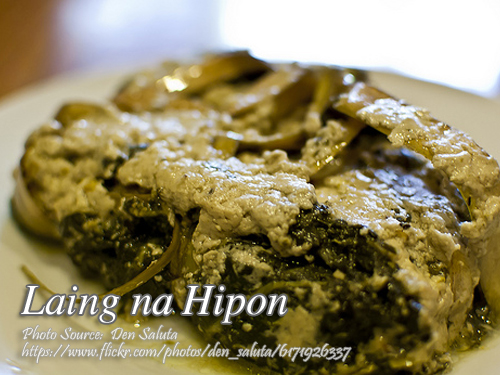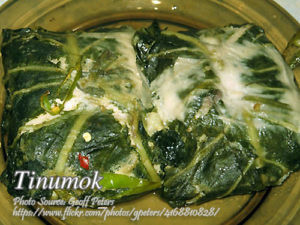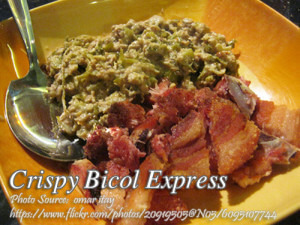Laing na hipon is a version of laing that you wrap a shrimp mixture made from shrimps, grated young coconut and salt then wrapped in taro root leaves then cooked in coconut milk with chili peppers and onions. This is also called pinangat in Bicol region but this is only a variation of the dish because meat is the usual filling used in pinangat.
Laing na Hipon: A Taste of Home in Every Bite
Whenever I cook laing na hipon, I can’t help but think of my Uncle Tony back in Sorsogon. He was the one who first showed me how this dish comes together—not rushed, not complicated, but with a kind of patience that only someone who grew up surrounded by coconut trees and gabi (taro) patches can have. He would always say, “The secret is in the coconut milk. Don’t let it boil too fast, or it will split.” And true enough, that gentle simmer gives this dish its velvety texture and deep flavor.
Growing up, laing was always present in our family gatherings. But it wasn’t always the shrimp version. More often than not, it was the classic Bicolano pinangat with pork or fish. It wasn’t until my cousin Liza came home from Camarines Norte that I tasted laing na hipon for the first time. She had learned it from her neighbor, Aling Rosa, who insisted that wrapping shrimps in gabi leaves with grated coconut brings out a lighter, almost sweet flavor compared to meat. That single bite was enough to hook me, and I knew I had to learn how to cook it myself.
What Makes Laing na Hipon Special
This dish is more than just a recipe—it’s a story of resourcefulness and tradition. In Bicol, pinangat is a beloved staple, often made with meat or fish. Laing na hipon is considered a cousin of the original, a humble yet elegant variation that swaps pork with fresh shrimps. The flavor is cleaner, the texture softer, and it carries the distinct sweetness of the sea.
The preparation may seem simple, but each step has meaning. Mixing shrimps with freshly grated coconut and onions gives the filling a rich body. Wrapping them in gabi leaves not only keeps everything intact but also adds a subtle earthy note that balances the richness of the gata (coconut milk). And then there’s the coconut milk itself—the heart of the dish. Starting with the thin coconut milk before adding the thicker cream later is not just tradition, it’s technique. The slow simmer allows the gabi leaves to soften without turning bitter, while the final addition of thick gata and siling labuyo (bird’s eye chili) seals the dish with a luscious finish and that fiery kick Bicolanos are proud of.
A Lesson in Patience and Technique
One thing I learned from my grandmother, Lola Nena, is never to stir laing once it’s simmering. She would always remind me to gently shake the pot instead. At first, I thought it was just one of those old-fashioned kitchen superstitions. But as I grew older and paid more attention, I realized it was a practical technique. Stirring can tear the gabi leaves and make the sauce gritty, while shaking the pot keeps the wraps intact and prevents burning at the bottom.
The timing of the coconut milk is also worth noting. Thin coconut milk goes in first so the gabi leaves cook slowly and absorb the flavor. The thick coconut milk comes later, giving the sauce its signature creamy body. Skip this step, and the dish won’t have that deep, comforting richness we all love.
Food for Thought: The Roots of the Dish
Laing has deep roots in the Bicol region, where gabi leaves and coconut milk are abundant. Historically, families relied on these ingredients not only for their availability but also for their nutritional value. Gabi leaves are packed with fiber and minerals, while coconut milk provides healthy fats and energy. Adding shrimps to the mix was a natural evolution in coastal towns, where seafood is easier to catch than pork or beef.
What I love most about laing na hipon is how it tells a story of place. In every wrap, you taste the land and the sea working together. It’s a dish that shows how Filipinos adapt recipes to what’s around them, creating variations that are just as authentic and meaningful as the original.
Cooking Laing na Hipon at Home
When I make this at home now, I follow the same process my relatives taught me. I start by mixing fresh shrimps with onions and grated coconut, just a little salt to taste. Then I carefully wrap spoonfuls of the mixture in gabi leaves, folding them tightly so nothing escapes. The wrapped bundles go into a pot, where I pour thin coconut milk over them. From there, it’s all about patience—letting it simmer slowly, shaking the pot once in a while, and adding the thicker coconut milk and chilies toward the end.
When the sauce thickens and coats the gabi leaves like silk, I know it’s ready. Served hot with steaming white rice, laing na hipon never fails to transport me back to those afternoons in Sorsogon, watching Uncle Tony stir coconut milk with a slow hand and a big smile.
Cooking this dish isn’t just about feeding the stomach—it’s about keeping alive the flavors and traditions that remind us of home.
How to Cook Laing na Hipon (Shrimps with Taro Leaves)
Ingredients
- 1/2 kilo hipon shrimps, shelled and chopped finely
- 1 cup thin coconut milk reserve thick coconut milk
- 2 pcs small young coconuts grated
- 2 pcs siling labuyo hot chili peppers
- 1 pc onion chopped
- 1 tsp salt
- 10 to 15 pcs wilted gabi leaves taro root leaves
Instructions
How to cook Laing Na Hipon
- Mix shelled shrimps (hipon) with onion, grated coconuts and salt.
- Wrap about 1 tablespoon of shrimp mixture in gabi leaves.
- Arrange in a pot. Pour thin coconut milk overwrapped mixture.
- Cover. Simmer over low fire.
- Shake pot to avoid burning of wrapped mixture.
- Add thick coconut milk and siling labuyo when slightly cooked.
- Continue cooking until sauce thickens. Serve while hot.
Notes
Cooking Tips:
Use Fresh Gabi Leaves
Always choose young, tender gabi leaves when wrapping the shrimp mixture. Older leaves can turn tough and sometimes leave an itchy feeling on the tongue. Washing and patting them dry before use also helps remove excess moisture and bitterness.Control the Heat of Coconut Milk
Start with a gentle simmer when cooking in thin coconut milk to avoid curdling or separating. High heat will break the cream and ruin the sauce’s silky texture. Slow cooking allows the flavors to meld beautifully into the gabi leaves and shrimp.Shake, Don’t Stir
Instead of stirring the pot, gently shake it from side to side to prevent burning. Stirring may break the gabi leaf wraps and release the filling too soon. Shaking keeps the bundles intact and evenly coats them with coconut milk.






what is thin and thick coconut milk we only have a can milk?
@helen hernandez
Thick coconut milk is the first coconut milk extracted from fresh shredded mature coconut meat by squeezing. Then to get the thin coconut milk, dilute 2 cups on the shredded coconut and squeeze again and strain to separate the shredded coconut from the milk. In the canned version, the thick coconut milk is labeled as “coconut cream” and the thin coconut milk is just the ordinary canned coconut milk.